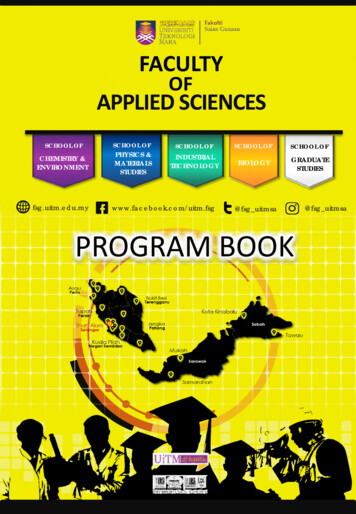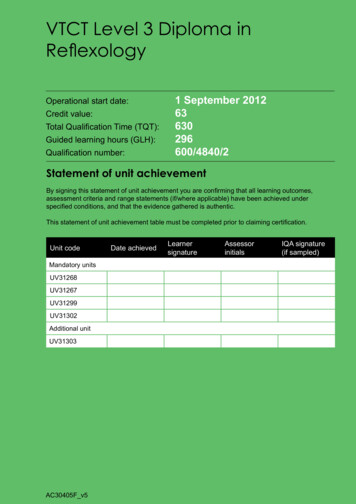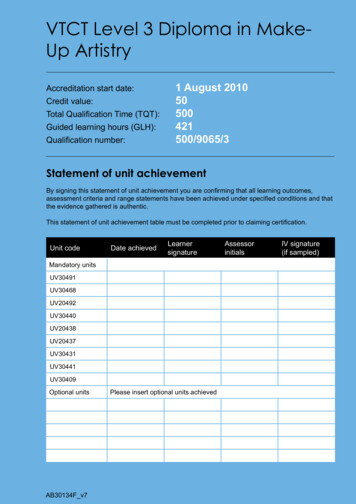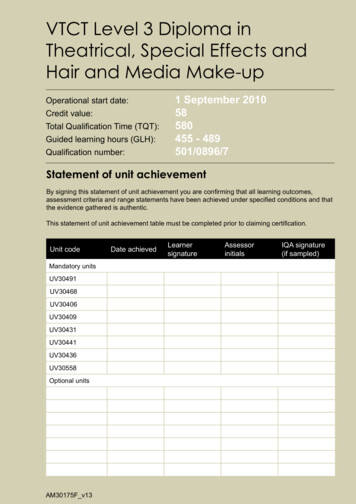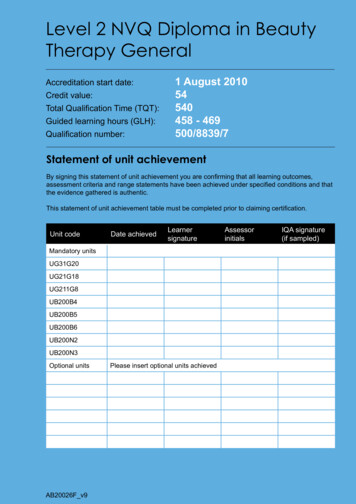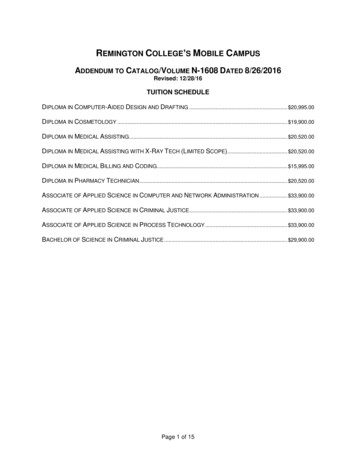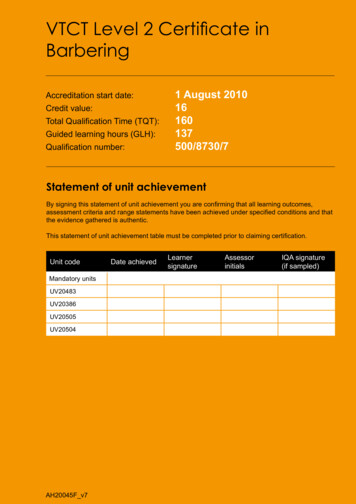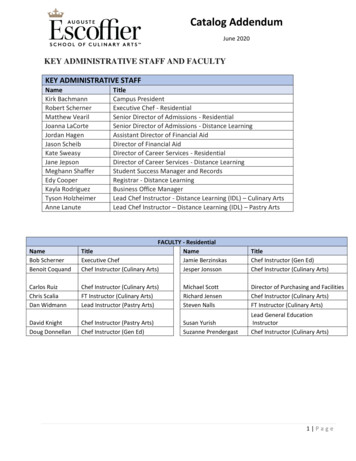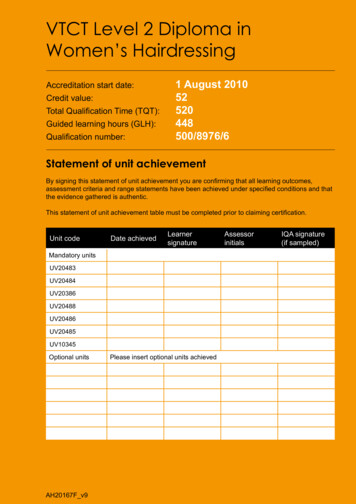
Transcription
VTCT Level 2 Diploma inWomen’s Hairdressing1 August 2010Credit value: 52Total Qualification Time (TQT):520Guided learning hours (GLH):448Qualification number: 500/8976/6Accreditation start date:Statement of unit achievementBy signing this statement of unit achievement you are confirming that all learning outcomes,assessment criteria and range statements have been achieved under specified conditions and thatthe evidence gathered is authentic.This statement of unit achievement table must be completed prior to claiming certification.Unit codeDate achievedLearnersignatureMandatory 0345Optional unitsAH20167F v9Please insert optional units achievedAssessorinitialsIQA signature(if sampled)
The qualificationIntroductionThe VTCT Level 2 Diploma in Women’sHairdressing is a qualification that has beenspecifically designed to develop your practicalskills in; the creative art of cutting or dressingwomen’s hair, how to provide effectiveshampooing and conditioning services, theartistic skill of colouring and lightening hair andhow to provide a good consultation servicefor your clients.To further enhance your practical skills youwill have the opportunity to choose from thefollowing units; how to provide perming andneutralising services, effective scalp massageservices, how to create a hair and beauty image,plaiting and twisting hair, colouring hair usingsemi and temporary colour, style and finishAfrican type hair, displaying stock or promotingproducts and services to clients and theopportunity of working on a salon reception.Underpinning this qualification you will developa sound knowledge and understanding of eachunit including health and safety and what it islike to work in the hairdressing industry.The purpose of this qualification is todevelop your practical skills to a high level ofoccupational ability to enable you to performyour own salon services.PrerequisiteThere are no formal prerequisite qualificationsthat you must have prior to undertaking thisqualification.2National Occupational Standards (NOS)Units in this qualification have been mappedto the relevant NOS (where applicable). Thisqualification is regulated on the RegulatedQualifications Framework.This qualification is approved and supported bythe Hairdressing and Beauty Industry Authority(HABIA), the standard setting body for hair,beauty, nails and spa qualifications.
ProgressionWhen you have successfully completedthis qualification will have the opportunity toprogress to the following VTCT qualifications:NVQ qualifications: Level 2 NVQ Diploma in Hairdressing(Combined Hair Types) Level 2 NVQ Diploma in Barbering Level 2 NVQ Diploma in ChemicallyTreated African Type Hair Level 2 NVQ Diploma in Treating NaturalAfrican Type Hair Level 2 NVQ Diploma in Barbering AfricanType Hair Level 3 NVQ Diploma in Hairdressing Level 3 Certificate in Creative Hair Design Level 3 Award in Cutting Women’s Hair Level 3 Award in Bridal HairstylingThis qualification may lead directly intoemployment in a salon as a junior stylist or towork as an independent hairdresser.Progression opportunities also exist in theform of specialist VTCT vocationally relatedqualifications: Level 2 Diploma in Barbering Level 2 Diploma in African CaribbeanHairdressing Level 2 Certificate in Barbering Level 2 Certificate in African CaribbeanHairdressing Level 2 Award in Wig Services Level 2 Award in Emergency First Aid atWork Level 2 Award in Preventing ContactDermatitis Level 3 Diploma in Women’s Hairdressing Level 3 Certificate in Perming Hair Level 3 Certificate in Colouring Hair Level 3 Certificate in Hair ExtensionsServices3
Qualification structureTotal credits required - 52 (minimum)All mandatory units must be completed.Mandatory units VTCT unitcodeOfqual unitreferenceUnit titleUV20483R/600/8763UV20484Credit valueGLHFollow health and safety practice in thesalon322M/600/8611Working in the hair industry435UV20386A/600/9065Client consultation for hair services330UV20488H/600/8539Shampoo and condition the hair and scalp329UV20486A/600/8630Colour and lighten hair1091UV20485T/600/8612Cut women’s hair875UV10345Y/502/3979The art of dressing hair530Credit valueGLHOptional units -436 credits16 (minimum) creditsVTCT unitcodeOfqual unitreferenceUnit titleUV20512Y/600/8537Perm and neutralise hair760UV20490J/600/8761Display stock to promote sales in a salon324UV20492T/600/8769Promote products and services to clientsin a salon328UV20499J/600/8632Create an image based on a theme withinthe hair and beauty sector760UV20513L/600/8535Provide scalp massage services433UV20489A/600/8773Salon reception duties324UV30342Y/502/3805Plaiting and twisting hair330UV20494T/600/8626The art of colouring hair760UV20514T/600/8531Style and finish African type hair545
Guidance on assessmentThis book contains the mandatory units that make up this qualification. Optional units will beprovided in additional booklets (if applicable). Where indicated, VTCT will provide assessmentmaterials. Assessments may be internal or external. The method of assessment is indicated ineach unit.Internal assessment(any requirements will be shown in the unit)Assessment is set, marked and internallyquality assured by the centre to clearlydemonstrate achievement of the learningoutcomes. Assessment is sampled by VTCTexternal quality assurers.External assessment(any requirements will be shown in the unit)Externally assessed question paperscompleted electronically will be set and markedby VTCT.Externally assessed hard-copy question paperswill be set by VTCT, marked by centre staff andsampled by VTCT external quality assurers.Assessment explainedVTCT qualifications are assessed and qualityassured by centre staff. Work will be set toimprove your practical skills, knowledge andunderstanding. For practical elements, you willbe observed by your assessor. All your workmust be collected in a portfolio of evidence andcross-referenced to requirements listed in thisrecord of assessment book.Your centre will have an internal quality assurerwhose role is to check that your assessmentand evidence is valid and reliable and meetsVTCT and regulatory requirements.An external quality assurer, appointed byVTCT, will visit your centre to sample andquality-check assessments, the internal qualityassurance process and the evidence gathered.You may be asked to attend on a different dayfrom usual if requested by the external qualityassurer.This record of assessment book is yourproperty and must be in your possession whenyou are being assessed or quality assured. Itmust be kept safe. In some cases your centrewill be required to keep it in a secure place.You and your course assessor will togethercomplete this book to show achievement of alllearning outcomes, assessment criteria andranges.5
Creating a portfolio of evidenceAs part of this qualification you are required toproduce a portfolio of evidence. A portfolio willconfirm the knowledge, understanding and skillsthat you have learnt. It may be in electronic orpaper format.Your assessor will provide guidance on how toprepare the portfolio of evidence and how toshow practical achievement, and understandingof the knowledge required to successfullycomplete this qualification. It is this bookletalong with the portfolio of evidence that willserve as the prime source of evidence for thisqualification.Evidence in the portfolio may take the followingforms: Observed workWitness statementsAudio-visual mediaEvidence of prior learning or attainmentWritten questionsOral questionsAssignmentsCase studiesAll evidence should be documented in theportfolio and cross referenced to unit outcomes.Constructing the portfolio of evidence should notbe left to the end of the course.6
Unit assessment methodsThis section provides an overview of the assessment methods that make up each unit in thisqualification. Detailed information on assessment is provided in each unit.Mandatory unitsExternalVTCT unitcodeUnit Assignment(s)Follow health and safety practice inthe salon1 UV20484Working in the hair industry0UV20386Client consultation for hair services1 UV20488Shampoo and condition the hair andscalp1 UV20486Colour and lighten hair1UV20485Cut women’s hair1UV10345The art of dressing hair1 Optional unitsExternalVTCT unitcodeUnit Assignment(s)Perm and neutralise hair1 UV20490Display stock to promote sales in asalon0 UV20492Promote products and services toclients in a salon0 UV20499Create an image based on a themewithin the hair and beauty sector0 UV20513Provide scalp massage services1UV20489Salon reception duties0UV30342Plaiting and twisting hair0UV20494The art of colouring hair1UV20514Style and finish African type hair0 7
Unit glossaryDescription8VTCT productcodeAll units are allocated a unique VTCT product code for identification purposes.This code should be quoted in all queries and correspondence to VTCT.Unit titleThe title clearly indicates the focus of the unit.NationalOccupationalStandards(NOS)NOS describe the skills, knowledge and understanding needed to undertake aparticular task or job to a nationally recognised level of competence.LevelLevel is an indication of the demand of the learning experience, the depth and/orcomplexity of achievement and independence in achieving thelearning outcomes.Credit valueThis is the number of credits awarded upon successful achievement of all unitoutcomes. Credit is a numerical value that represents a means of recognising,measuring, valuing and comparing achievement.GuidingLearning hours(GLH)The activity of a learner in being taught or instructed by - or otherwiseparticipating in education or training under the immediate guidance or supervisionof - a lecturer, supervisor, tutor or other appropriate provider of education ortraining.Totalqualificationtime (TQT)The number of hours an awarding organisation has assigned to a qualification forGuided Learning and an estimate of the number of hours a learner will reasonably belikely to spend in preparation, study, or any other form of participation in education ortraining. This includes assessment, which takes place as directed - but, unilke GuidedLearning, not under the immediate guidance or supervision of - a lecturer, supervisor,tutor or other appropriate provider of education or training.ObservationsThis indicates the minimum number of observations required to achieve the unit.LearningoutcomesThe learning outcomes are the most important component of the unit, they set outwhat is expected in terms of knowing, understanding and practicalability as a result of the learning process. Learning outcomes are the results oflearning.EvidencerequirementsThis section provides guidelines on how evidence must be gathered.Maximumservice timesThe maximum time in which a particular service or practical element must becompleted.ObservationoutcomeAn observation outcome details the practical tasks that must be completed toachieve the unit.KnowledgeoutcomeA knowledge outcome details the theoretical requirements of a unit that mustbe evidenced through oral questioning, a mandatory written question paper orportfolio of evidence.AssessmentcriteriaAssessment criteria set out what is required, in terms of achievement, to meeta learning outcome. The assessment criteria and learning outcomes are thecomponents that inform the learning and assessment that should take place.Assessment criteria define the standard expected to meet learning outcomes.RangeThe range indicates what must be covered. Ranges must be practicallydemonstrated in parallel to the unit’s observation outcomes.
UV20483Follow health and safetypractice in the salonThe aim of this unit is to increase your understanding ofhealth and safety and its importance in the salon in whichyou work.You will develop the ability to carry out a simple riskanalysis, recognise a hazard, responsibly deal with thehazards you have found and follow safe and hygienicworking practices.You will also need to be able to locate fire fightingequipment, first aid resources and have an awareness offire, emergency and evacuation procedures.This unit applies to hairdressing, beauty therapy, nail andbarbering salons and spas.UV20483 v7
Level2Credit value3GLH22Observation(s)3External paper(s)1
Follow health and safetypractice in the salonLearning outcomesOn completion of this unit you will:1.Be able to maintain health, safety andsecurity practices2.Be able to follow emergency proceduresEvidence requirements1.EnvironmentEvidence for this unit must be gathered in areal or realistic working environment.2.SimulationSimulation is not allowed in this unit.3.Observation outcomesCompetent performance of ‘Observation’outcomes must be demonstrated to yourassessor on at least three occasions.4.Knowledge outcomesThere must be evidence that you possessall the knowledge and understandinglisted in the ‘Knowledge’ section of thisunit. This evidence may include projects,assignments, case studies, reflectiveaccounts, oral/written questioning and/orother forms of evidence.5.Tutor/Assessor guidanceYou will be guided by your tutor/assessoron how to achieve learning outcomes in thisunit. All outcomes must be achieved.6.External paperKnowledge and understanding in this unitwill be assessed by an external paper.The criteria that make up this paper arehighlighted in white throughout this unit.There is one external paper that must beachieved.UV20483 11
Achieving observationsand rangeAchieving observation outcomesYour assessor will observe your performanceof practical tasks. The minimum numberof observations required is indicated in theevidence requirements section of this unit.Criteria may not always naturally occur duringa practical observation. In such instances youwill be asked questions to demonstrate yourcompetence in this area. Your assessor willdocument the criteria that have been achievedthrough oral questioning.Your assessor will sign off an outcome when allcriteria have been competently achieved in asingle client service.Achieving rangeThere are no range statements that apply to thisunit.12 UV20483Maximum service timesThere are no maximum service times that applyto this unit.
ObservationsOutcome 1Be able to maintain health, safety and security practicesYou can:a.Conduct yourself in the workplace to meetwith health and safety practices and salonpolicyb.Deal with hazards within your own area ofresponsibility following salon policyc.Maintain a level of personal presentation,hygiene and conduct to meet with legal andsalon requirementsd.e.Follow salon policy for securityf.g.h.Use required personal protective equipmenti.Dispose of all types of salon wastesafely and to meet with legal and salonrequirementsMake sure tools, equipment, materials, andwork areas meet hygiene requirementsPosition yourself and the client safelyHandle, use, and store products, materials,tools, and equipment safely to meet withmanufacturer’s instructions*May be assessed through oral questioning.Observation123Date achievedCriteria questioned orallyPortfolio referenceAssessor initialsLearner signature UV2048313
HabiaOutcome 2Be able to follow emergency proceduresYou can:a.b.Follow emergency proceduresc.Locate fire fighting equipmentFollow accident reporting procedures whichmeet with salon policy*May be assessed through oral questioning.ObservationDate achievedCriteria questioned orallyPortfolio referenceAssessor initialsLearner signature14 UV204831OptionalOptional
Developing knowledgeAchieving knowledge outcomesYou will be guided by your tutor and assessoron the evidence that needs to be produced.Your knowledge and understanding will beassessed using the assessment methods listedbelow: Where possible your assessor will integrateknowledge outcomes into practical observationsthrough oral questioning.Observed workWitness statementsAudio-visual mediaEvidence of prior learning or attainmentWritten questionsOral questionsAssignmentsCase studiesAchieving the external paperThe external paper will test your knowledge of the criteria highlighted in white. A pass mark of70% must be achieved. Criteria not achieved will be identified to your tutor/assessor. You will thenbe orally questioned or asked to produce other forms of evidence as all unit criteria mustbe achieved.Your assessor will complete the following table when the 70% pass mark has been achieved.PaperDate achievedAssessor initials1 of 1 UV2048315
KnowledgeOutcome 1Be able to maintain health, safety and security practicesYou can:j.Explain the difference between legislation, codes of practice andworkplace policiesk.Outline the main provisions of health and safety legislationl.State the employer’s and employee’s health and safetyresponsibilitiesm. State the difference between a ‘hazard’ and a ‘risk’n.Describe hazards that may occur in a salono.State the hazards which need to be referredp.State the purpose of personal protective equipment used in asalon during different servicesq.State the importance of personal presentation, hygiene, andconduct in maintaining health and safety in the salonr.State the importance of maintaining the security of belongingss.Outline the principles of hygiene and infection controlt.Describe the methods used in the salon to ensure hygieneu.Describe the effectiveness and limitations of different infectioncontrol techniquesv.Describe how to dispose of different types of salon waste*Assessor initials to be inserted if orally questioned.Requirements highlighted in white are assessed in the external paper.16 UV20483Portfolio reference /Assessor initials*
HabiaOutcome 2Be able to follow emergency proceduresYou can:d.Identify named emergency personnele.Describe procedures for dealing with emergenciesf.Outline the correct use of fire fighting equipment for different typesof fireg.State the dangers of the incorrect use of fire fighting equipment ondifferent types of firesh.State the importance for reporting and recording accidentsi.Describe the procedure for reporting and recording accidentsPortfolio reference /Assessor initials**Assessor initials to be inserted if orally questioned.Requirements highlighted in white are assessed in the external paper. UV2048317
Unit contentThis section provides guidance on the recommended knowledge and skills required to enable youto achieve each of the learning outcomes in this unit. Your tutor/assessor will ensure you have theopportunity to cover all of the unit content.Outcome 1: Be able to maintain health, safety and security practicesHazards and risks: A hazard is somethingthat has the potential to cause harm. A riskis the likelihood of a hazard happening.Salon hazards: Require immediateaction – refer to job description, level ofresponsibility, report, duty to recognise/deal with hazards, training on dealingwith hazards, deal with hazards withoutendangering self/others, if in doubt call forassistance, nominated personnel, duty torecognise/deal with hazards.Environmental – wet/slippery floor,cluttered passage/corridors, rearrangefurniture, blocked passageway/entrance/exit.Equipment – broken, worn, faulty,incorrect use.Chemicals – leaking, damaged packaging.Security (cash) – unattended reception/till,money in transit, cash left in till overnight.Security (people) – staff, clients, visitors,children, personal belongings, disregard ofsystems (security, emergency evacuation,storage/use of confidential staff/clientrecords, business information).Hygiene – poor personal cleanliness, lackof regular washing of uniform, equipment(dirty, not sterilised, cross-infection,cross‑contamination between clients.Salon policy for security:Cash – staff training, point of sale, regularbanking, in transit.18 UV20483People – staff, clients, visitors, children,personal belongings, systems (security,emergency evacuation, storage/use ofconfidential staff/client records, businessinformation).Belongings – client to retain personalbelongings where possible, empty pocketsprior to hanging coat, staff belongings to remainin staff room, avoid personal items in salon.Security breaches – inform salon owner/head of school, review records (stocklevels/control, monitor takings, inventoryof equipment, manual and computerisedrecords), take statements, eye witnessaccounts, review findings, call in police,notify data protection registry/clients ofbreach, maintain confidentiality, could resultin loss of employment.Use of tools and equipment: Comply withlegislation, health and safety, electricity atwork, portable appliance testing, reportingof injuries and dangerous diseases,manual handling, visual checks, only usefor intended purpose, no trailing wires,manufacturer’s instructions, fit for purpose.Maintenance of tools and equipment:Equipment and tools cleaned, washed,appropriate sterilisation (barbicide, autoclave,UV, sterilising spray), complete destruction ofall living organisms on tools and equipment,disinfection (remove contamination from hardsurfaces), heat or chemical methods, visualcheck, remove and label broken tools andequipment, store correctly.
HabiaOutcome 1: Be able to maintain health, safety and security practices (continued)Preparation of work area: Work station/bed/chair/trolley, equipment cleaned,appropriate sterilisation (barbicide,autoclave, UV, sterilising spray), completedestruction of all living organisms on toolsand equipment, disinfection (removecontamination from hard surfaces, largework areas, floors and work surfaces),heat or chemical methods, bactericides,fungicides, viricides, full access aroundwork area, safe professional presentationtools and equipment, visual check on large/small equipment, portable appliance tested,bed/seat/basin (select height).How to follow safe and hygienic workingpractices:Maintaining a safe salon – all staff toadhere to salon policies, clean, tidy, safestandards of working, remove spillages, reportslippery surfaces, remove/report obstacles,clear access to work stations/beds/trolleysand equipment, clean/sterilise/disinfecttools, equipment and work surfaces, riskassessment, no smoking, eating, drinking ordrugs in salon, professional personal hygiene.Personal protective equipment – avoid latex,powdered gloves, apron, protective glasses.Electricity at work – visual check ofequipment, no trailing wires, portableappliance testing.Manual handling – moving stock safely,lifting, working heights, unpacking.Towels – clean for every client, place dirtytowels in covered bin.Reporting of injuries diseases anddangerous occurrences – accident book,reporting diseases, log accidents.Control of substances hazardous tohealth – store, handle, use, disposal,replace lids, ventilation for vapour anddust, avoid over exposure to chemicals,use manufacturer’s instructions for use.Disposal of waste – sharps box, closedtop bin, dilute chemicals with runningwater, environmental protection, salonpolicies for hazardous waste, single useitems, recycle empties.Behave professionally in a salonenvironment: Follow health and safetypractices and procedures, follow saloncode of conduct, respect and co‑operatewith others (team work – be sympathetic,fair, not aggressive), avoid gossip, valueclient(s), use appropriate language,maintain confidentiality, uphold a polite,cheerful and friendly manner (friendlyfacial expressions, open body language,positive attitude), eye contact, sensiblebehaviour, take pride in work, be punctual,employer and client loyalty.How to maintain personal presentationand hygiene: Clothes/uniform (washed/ironed daily), hair (clean, healthy,manageable, off face), personal hygiene(shower daily, clean teeth, fresh breathdeodorant, avoid overpowering perfume/aftershave), workable length clean nails(hair), short clean nails (beauty), minimaljewellery/no jewellery, light fresh make‑up,comfortable clean shoes, wash handsbetween clients, cover cuts and woundswith plaster, wear personal protectiveequipment.Risk: The likelihood of a hazardhappening, risk assessment, determine thelevel of risk, preventative measures, reduce UV2048319
HabiaOutcome 1: Be able to maintain health, safety and security practices (continued)a potentially harmful situation, judgementof salon hazards, who/what/level of risk,interpret results, conclusions, recordfindings, regular reviews.Position yourself and the clientappropriately:Stylist/therapist/nail technician – positionself safely, when you sit or stand ensuregood posture (straight back, stand upright,even weight distribution, maintain balance,remain relaxed, don’t overstretch), poorposture will result in fatigue, unevenservice, back/shoulder injury.Client – seated/laid comfortably (adjustheight of chair, adjust back rest of bed),if seated keep feet flat on floor, legsuncrossed, back supported, regular comfortbreaks.The difference between health andsafety legislation, regulations and codeof conduct:Legislation and regulations –government lead, implemented, monitored.Code of practice and policies – salonlead, implemented, monitored.Salon health and safety legislationand regulations: Health and safety atwork, control of substances hazardousto health, reporting of injuries diseasesand dangerous occurrences, personalprotective equipment, electricity at work,manual handling, supply of goods andservices, trade description, data protection,employer’s liability (compulsory insurance),occupier’s liability, local by‑laws (set bycouncil), salon rules, code of conduct,observance by all staff.20 UV20483Employer responsibility for safety ofstaff/employees/clients: Hold current/valid liability insurance, display health andsafety rules covering staff/employees/clients/fire evacuation, provide regulartraining, accurate record keeping,monitoring, consult experts.
HabiaOutcome 2: Be able to follow emergency proceduresEmergency procedures:Accidents – call ambulance, internalemergency number, nominated first aider,records.Incorrect use of fire fighting equipment:Fire could deteriorate/uncontrollable,injury to personnel, damage to belongings/property.First aid – call nominated first aider,emergency internal number, ensureaccurate records.First aid equipment – first aid box(es),list of equipment, general advice leaflet,various sized dressings, eye pad, eye bath,triangular bandages, safety pins, antisepticcream, medical wipes, sterile gloves, sterilewater, cotton wool.Fire evacuation – nominated assemblypoint, fire wardens, regular simulation.Incidents – call security, emergencyinternal number, emergency externalnumbers 999 (UK) or 112 (EU).Position of fire fighting equipment –induction process.How to use fire fighting equipment– designated personnel, initial/ongoingtraining.Records and documentation – initial/ongoing training, up-to-date, accurate.Safety drills – induction process, initial/ongoing training person, regular simulation.Personnel responsible for safety –nominated health and safety officer(internal/external).Fire fighting equipment: Location,extinguishers (water, foam, powder, CO2gas), sand bucket, fire blanket, alarm. UV2048321
NotesUse this area for notes and diagrams22UV20483
UV20484Working in the hair industryThrough this unit you will develop a sound knowledge ofhow the hairdressing industry works. You will researchthe types of services, roles and responsibilities of staff,available career opportunities, legislation that governs thehair industry, good working practices, employment rightsand responsibilities of staff.This unit is suitable for both hairdressers and barbers.UV20484 v6
Level2Credit value4GLH35Observation(s)0External paper(s)0 Wahl
Working in the hair industryLearning outcomesOn completion of this unit you will:1.Be able to describe the key characteristicsof the hair industry2.Be able to describe working practices in thehair industryEvidence requirements1.Knowledge outcomesThere must be evidence that you possessall the knowledge and understandinglisted in the ‘Knowledge’ section of thisunit. This evidence may include projects,assignments, case studies, reflectiveaccounts, oral/written questioning and/orother forms of evidence.2.Tutor/Assessor guidanceYou will be guided by your tutor/assessoron how to achieve learning outcomes in thisunit. All outcomes must be achieved.3.External paperThere is no external paper requirement forthis unit.UV2048425
Developing knowledgeAchieving knowledge outcomesYou will be guided by your tutor and assessoron the evidence that needs to be produced.Your knowledge and understanding will beassessed using the assessment methods listedbelow: 26Observed workWitness statementsAudio-visual mediaEvidence of prior learning or attainmentWritten questionsOral questionsAssignmentsCase studiesUV20484Where possible your assessor will integrateknowledge outcomes into practical observationsthrough oral questioning.
KnowledgeOutcome 1Be able to describe the key characteristics of the hair industryYou can:a.Access sources of information on organisations, services, occupationalroles, education and training opportunities within the hair industryb.Outline the types of organisations within the hair industryc.Outline the main services offered by the hair industryd.Describe occupational roles within the hair industrye.State the employment characteristics of working in the hair industryf.State career patterns within the hair industryg.Outline the education and training opportunities within the hair industryh.Outline opportunities to transfer to other sectors or industriesPortfolio reference /Assessor initials**Assessor initials to be inserted if orally questioned.Requirements highlighted in white are assessed in the external paper.UV2048427
WahlOutcome 2Be able to describe working practices in the hair industryYou can:a.Outline good working practices in the salonb.State the importance of personal presentation in reflecting theprofessional image of the hair industryc.Outline
Women's Hairdressing Accreditation start date: 1 August 2010 Credit value: 52 Total Qualification Time (TQT): 520 Guided learning hours (GLH): 448 Qualification number: 500/8976/6 Statement of unit achievement By signing this statement of unit achievement you are confirming that all learning outcomes,

